An IPv6 address is a 128-bit alphanumeric identifier that identifies an endpoint device in an Internet Protocol Version 6 (IPv6) network. IPv6 is the successor to IPv4, which has constraints that IPv6 was designed to overcome.
Understanding the 128-bit notion
We all know that IPv6 is a 128-bit addressing scheme, but do we actually understand what this means in context?
128 bits = 8 sets × 4 hexadecimal numbers x 4 bits.
This signifies IPv6 addresses with 128 bits have 8 sets, each with a maximum of 4 hexadecimal numbers, and each number is a 4-bit combination.
A colon separates each of these eight sets (:)
Let’s delve a little deeper.
It is quite simple to convert from hexadecimal to binary or vice versa. If you wish to practice the conversion, you can use the table below, which illustrates decimal, binary, and hexadecimal integers.
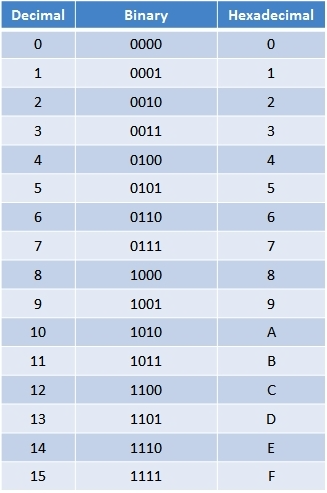
In the following example, I took one IPv6 address and converted it to binary:


We have clearly drawn all 128 bits of an IPv6 address here. Right?
So, regardless of the IP version we use, the address is divided into two parts: the network portion and the host portion.
To express the number of bits used for the network component in IPv4, you can use either the subnet mask or the prefix. In the case of IPv6, however, we can only use the prefix to display the number of bits used for the network part.
Because different network architectures have different network size needs, we must practically choose among the prefix-length(s) available to us in relation to the IP in question. Because choosing the proper prefix lengths is critical to minimizing IP address waste.
IPv6 Prefix Length vs IPv4 Prefix Length
The bits utilized for the network component of IPv4 can be displayed in either prefix or subnet mask format. However, for IPv6, we only represent it in the ‘prefix’ format.


IPv6 Address Types
IPv6 addresses fall into one of three categories:
- Unicast
- Multicast
- Anycast
Everything is dependent on how the source wishes to communicate with the destination. For e.g.
If the source only wants to connect with one destination, the unicast address will be used as the destination.
If the source wishes to interact with numerous devices at the same time, the multicast address will be used as a destination.
We can utilize Anycast addresses as identifiers for a group of interfaces that may belong to various nodes, and their IP addresses will be the same.
These three main categories are further subdivided, as shown in the diagram below:
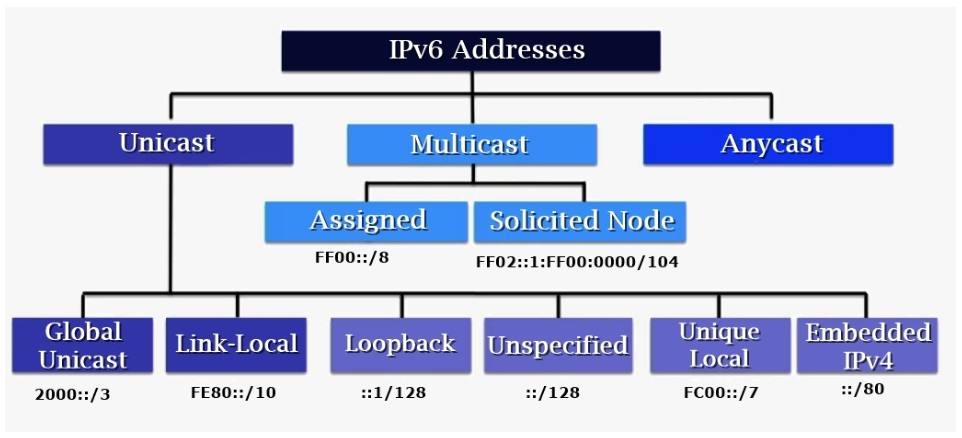

Unicast Addresses
An IPv6 unicast address identifies a single interface on a single node. A packet submitted to a unicast address is sent to the interface defined by that address.
There are several types of unicast addresses in IPv6:
- Global Unicast Address (GUA)
- Link-Local
- Loopback
- Unspecified
- Unique Local
Unicast Global Address (GUA)
When an IPv6-enabled device wishes to connect to the Internet, it requires an address that is unique across the Internet. The global unicast address is utilized for this purpose. It has a range of 2000::/3 to 3FFF::3 (first hex text: 2000::/3 to 3FFF::3). These addresses, like public IPv4 addresses, are globally unique and routable.
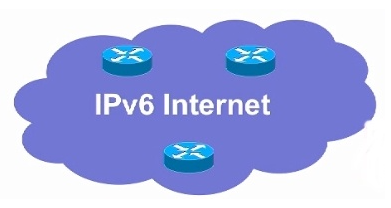

Unicast Link-Local
A link-local address is an IPv6 unicast address that may be configured automatically on any interface by using the link-local prefix FE80::/10 (First hex text: FE80::10 to FEBF::/10). A link is a network or subnet; this sort of address is not routable off the link and is unique to the link only. A link-local address is required for an IPv6 device.


This address is used by the following people:
• Before it has a GUA, hosts can communicate with the IPv6 network.
• Hosts utilize the link-local address of the router as the default gateway address.
• Routers near each other exchange routing updates.
• IPv6 routing tables’ next-hop addresses.
Address for Loopback
A node uses this to transmit an IPv6 packet to itself. An IPv6 loopback address performs the same purpose as an IPv4 loopback address (127.0.0.1). The IPv6 loopback address is 0000:0000:0000:0000:0000:0000:0000:0000:0000:0000:0000:0000:0000:0000:0000:0000:0000:0000:0000:0000:0000:0000:0000:0000:0000:0000:0000:0000:0000 It cannot be routed.
Address Unspecified
The unspecified address (0:0:0:0:0:0:0:0:0:0:0:0:0:0:0:0:0:0:0:0:0:0:0:0:0:0:0:0:0 It corresponds to the IPv4 undetermined address 0.0.0.0. When a unique address has not yet been discovered, the undefined address is normally utilised as a source address. An interface is never assigned an undetermined address.
Unique Local
This form of IPv6 address can be used by an enterprise organisation that has several sites and wants to use IPv6 addresses for communication. IPv6 Unique Local Addresses are defined in IETF RFC 4193 and have a range of FC00::/7 (first hex text: FC00::/7 to FDFF::/7). IPv4 addresses private IP addresses according to RFC 1918, but is not intended to be translated to a global unicast address (for security purposes).
10.0.0.0 – 10.255.255.255 (10/8 prefix)
172.16.0.0 – 172.31.255.255 (172.16/12 prefix)
192.168.0.0 – 192.168.255.255 (192.168/16 prefix)
This type of address should be used in a more restricted context, such as within a site or device that is not accessible via the global Internet. Acme Corp., in the example below, has four sites in different locations that are all linked to the Intranet. Each location has been assigned a unique local address.
IPv4 Embedded
A large number of devices on the Internet are already using IPv4 addresses, and it is not practical to convert all IPv4 addresses to IPv6 addresses in a short period of time. IPv6 offers backward compatibility with IPv4, which is achieved through the use of embedded IPv4 addresses.
IPv4 32-bit addresses are incorporated in IPv6 addresses. The first 96 bits of the address will be all zeros, with the last 32 bits representing an IPv4 address. As seen in the example below, we can easily map an IPv4 address to an IPv6 address.


Addresses for Multicast
When a source device wants to send a packet to numerous destinations at the same time (one-to-many), multicast addresses are appropriate.
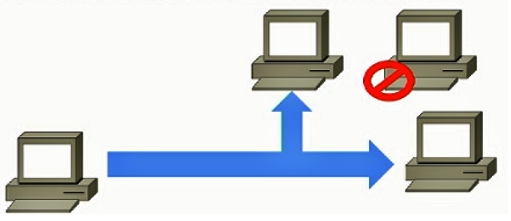

IPv6 multicast addresses have the same capabilities as IPv4 multicast addresses (224.0.0.0 through 239.255.255.255).
In IPv6, multicast eliminates the broadcast, whereas in IPv4, broadcasts are delivered to all devices in the broadcast domain or network, forcing all devices on the IPv4 network to process the broadcasts unnecessarily.
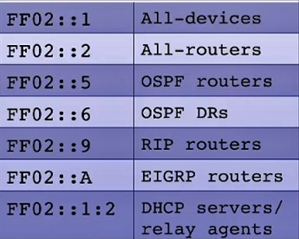

Anycast Address
A unicast address that is assigned to multiple interfaces (usually separate devices) that perform almost identical functions. The request is routed to the device closest to the user who sent the request. That choice is made by the router based on the optimum path in the routing table. You can read about how Cisco networks choose routes here.
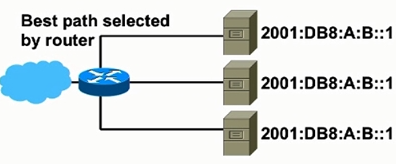

In the following IPv4 anycast address type example, there are two servers in different places with the same addresses. When a client sends a request to the server, Router1 will check its routing database and determine which server is closest to it based on the routing protocol calculation. In comparison to Server Instance-B, Server Instance-A has a shorter distance.
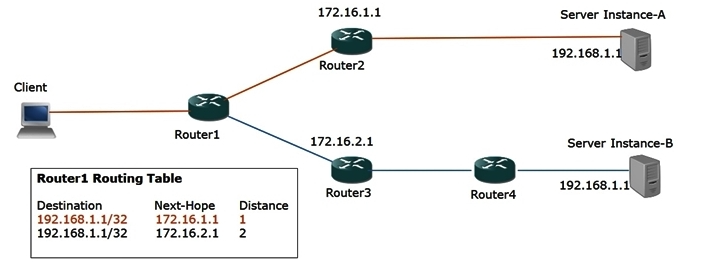

Router1 will choose the path > Router1 >Router2 >Server Instance -A and forward the request via that path. The topology will look like this from the perspective of Route 1:
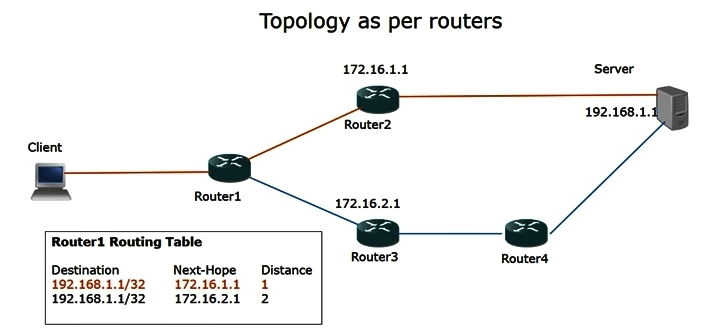

Anycast ensures high availability by distributing traffic load over multiple locations.
If a client is connected to the Router3 and submits a request to the server, Server Instance-B for the Router3 is close to Server Instance-A. As a result, any traffic that passes through Routers 1 and 2 will be routed to Server Instance-A. And the traffic from Routers 3 and 4 will be directed towards Server Instance-B. In this example, if Server Instance-A is unavailable, traffic from any of the routers will be routed to Server Instance-B.
